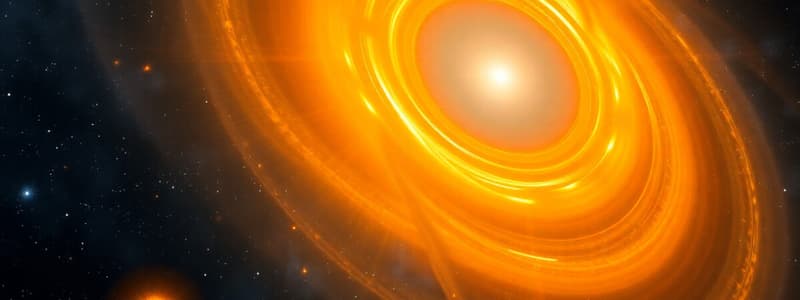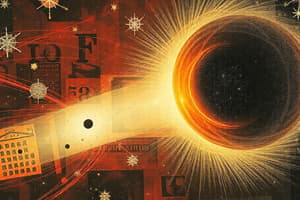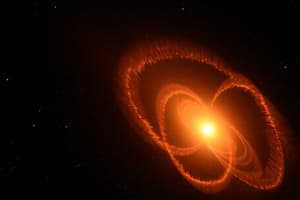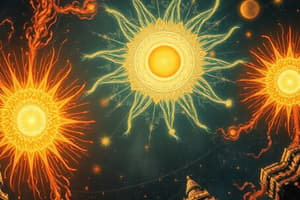Podcast
Questions and Answers
How did Tak Wah Mak's discovery regarding T-cell receptors revolutionize the understanding and treatment of immune-system diseases?
How did Tak Wah Mak's discovery regarding T-cell receptors revolutionize the understanding and treatment of immune-system diseases?
- By developing a novel method for isolating T-cells from the thymus gland, improving diagnostic accuracy.
- By revealing the unique genetic sequence and origin of T-cell receptor genes, opening new avenues for studying and treating immune disorders. (correct)
- By identifying specific antigens that trigger autoimmune responses, leading to targeted therapies.
- By creating a synthetic version of T-cell receptors, enhancing the body's natural immune response.
What was the primary challenge in immunology that Tak Wah Mak addressed through his research on T-cells?
What was the primary challenge in immunology that Tak Wah Mak addressed through his research on T-cells?
- Identifying the specific genes responsible for the development of autoimmune diseases.
- Determining the precise mechanism by which T-cells are produced in the bone marrow.
- Elucidating the process by which receptors on the surface of T-cells recognize antigens. (correct)
- Understanding the factors that regulate the differentiation of T-cells into various subtypes.
Which research approach did Tak Wah Mak utilize to expand his understanding of immune responses to cancer following his initial breakthrough with T-cell receptors?
Which research approach did Tak Wah Mak utilize to expand his understanding of immune responses to cancer following his initial breakthrough with T-cell receptors?
- He focused on identifying genetic mutations that predispose individuals to specific types of cancer.
- He developed novel methods for delivering chemotherapeutic drugs directly to cancer cells.
- He employed molecular techniques to investigate immune responses to cancer. (correct)
- He conducted epidemiological studies to identify environmental factors that contribute to cancer development.
What is the significance of Tak Wah Mak's discovery of the unique genetic sequence and origin of T-cell receptors used for antigen recognition?
What is the significance of Tak Wah Mak's discovery of the unique genetic sequence and origin of T-cell receptors used for antigen recognition?
Which of the following best describes the function of T-cells, the subject of Tak Wah Mak's groundbreaking research?
Which of the following best describes the function of T-cells, the subject of Tak Wah Mak's groundbreaking research?
What was the primary role of the radio telescopes designed and built by Jocelyn Bell Burnell and Antony Hewish?
What was the primary role of the radio telescopes designed and built by Jocelyn Bell Burnell and Antony Hewish?
Why did Jocelyn Bell Burnell initially label the pulsar signals as 'LGM-1'?
Why did Jocelyn Bell Burnell initially label the pulsar signals as 'LGM-1'?
How did Tak Wah Mak's research contribute to advancements in cancer treatment?
How did Tak Wah Mak's research contribute to advancements in cancer treatment?
What key property of pulsars allowed Jocelyn Bell Burnell and Antony Hewish to differentiate them from other celestial radio sources?
What key property of pulsars allowed Jocelyn Bell Burnell and Antony Hewish to differentiate them from other celestial radio sources?
What was the significance of Tak Wah Mak's 1984 publication in Nature?
What was the significance of Tak Wah Mak's 1984 publication in Nature?
In 1999, Tak Wah Mak identified a chemical to block the fuel supply of Hodgkin’s lymphoma. What does this imply about this form of cancer?
In 1999, Tak Wah Mak identified a chemical to block the fuel supply of Hodgkin’s lymphoma. What does this imply about this form of cancer?
How can Jocelyn Bell Burnell's experience with the Nobel Prize be viewed from a sociological perspective regarding gender and recognition in science?
How can Jocelyn Bell Burnell's experience with the Nobel Prize be viewed from a sociological perspective regarding gender and recognition in science?
Considering the impact and context of the 1967 discovery, what was a lasting impact from the observation of a pulsar?
Considering the impact and context of the 1967 discovery, what was a lasting impact from the observation of a pulsar?
Flashcards
Jocelyn Bell Burnell
Jocelyn Bell Burnell
First scientist to detect pulsars.
Pulsar
Pulsar
Rapidly rotating, strongly magnetized neutron star that emits a beam of electromagnetic radiation.
LGM-1 (Little Green Men-1)
LGM-1 (Little Green Men-1)
The name Jocelyn Bell Burnell playfully gave to pulsars before the term 'pulsar' was coined.
Bell Burnell's Discovery (1967)
Bell Burnell's Discovery (1967)
Signup and view all the flashcards
Discovery of Pulsars
Discovery of Pulsars
Signup and view all the flashcards
Tak Wah Mak
Tak Wah Mak
Signup and view all the flashcards
T-cells
T-cells
Signup and view all the flashcards
Genetic Research (Mak)
Genetic Research (Mak)
Signup and view all the flashcards
What are T-cells?
What are T-cells?
Signup and view all the flashcards
What are antigens?
What are antigens?
Signup and view all the flashcards
What are T-cell Receptors?
What are T-cell Receptors?
Signup and view all the flashcards
What are T-cell receptor genes?
What are T-cell receptor genes?
Signup and view all the flashcards
What was Mak's key discovery?
What was Mak's key discovery?
Signup and view all the flashcards
Study Notes
Jocelyn Bell Burnell
- Born in Belfast, Northern Ireland.
- Recognized physics was easy while at boarding school.
- Resolved to work in astronomy as a teenager.
- Graduated from Glasgow University in 1965.
- Began a PhD thesis at Cambridge University on twinkling quasars.
- Detected pulsars while a postgraduate student, opening a new branch of astrophysics.
- Worked under Antony Hewish, helping to design and build radio telescopes to detect quasars.
- In November 1967, instruments detected radio waves pulsating every 1.337 seconds from a fixed point in space.
- Determined that the radio waves came from the radiation beam of a rapidly rotating, strongly magnetized neutron star.
- Each rotation emitted a "pulse", giving the name "pulsar" to the new class of star.
- Playfully named the suspiciously precise radio waves LGM-1 (Little Green Men-1) until the term "pulsar" was coined in 1968.
- Antony Hewish reported her discovery in a Nature article in 1968.
- Her supervisor received the Nobel Prize in Physics in 1974, but she was not named in the award.
- Made a Dame Commander of the British Empire (DBE) in 2007 for her services to astronomy.
Tak Wah Mak
- Immunologist and molecular biologist.
- Discovered how T-cells recognize antigens.
- Advanced molecular understanding of cancer cells.
- Born in southern China in 1946.
- Spent childhood in Hong Kong.
- Moved to the US and studied at the University of Wisconsin.
- Gained a PhD in biochemistry at the University of Alberta, Canada, in 1968.
- Research on T-cells led to solving how receptors on the surface of T-cells recognize antigens.
- Discovered in 1983 that the genes of T-cell receptors used for antigen recognition have a unique genetic sequence and origin.
- Findings opened a new chapter in the study and treatment of immune-system diseases.
- Applied molecular techniques to learn more about immune responses to cancer.
- Accepted a fellowship at the Ontario Cancer Institute in 1972.
- Detailed the genetic encoding of human T-cell receptors in Nature journal in March 1984.
- Used experiments with mice to isolate genetic function for cancer and immunology studies in 1988.
- Identified a chemical to block the fuel supply of Hodgkin’s lymphoma in 1999.
Studying That Suits You
Use AI to generate personalized quizzes and flashcards to suit your learning preferences.





